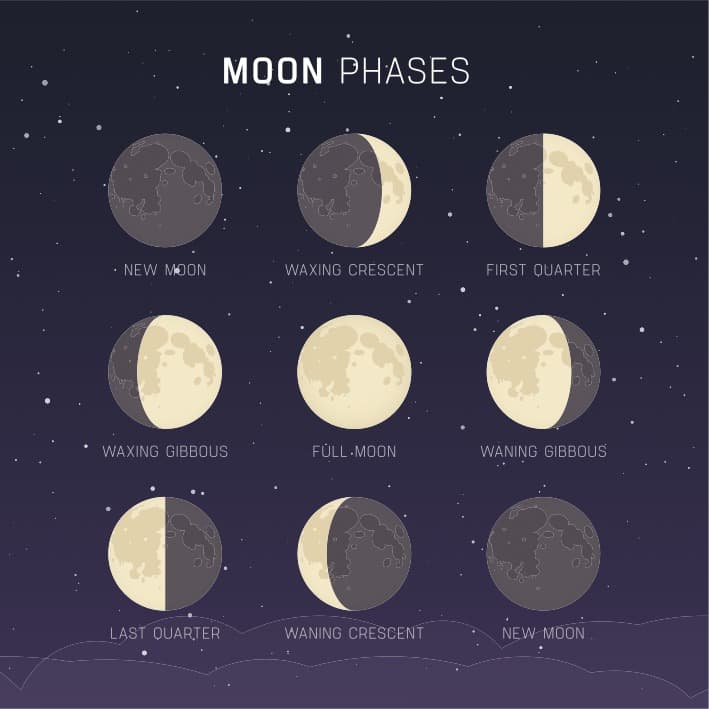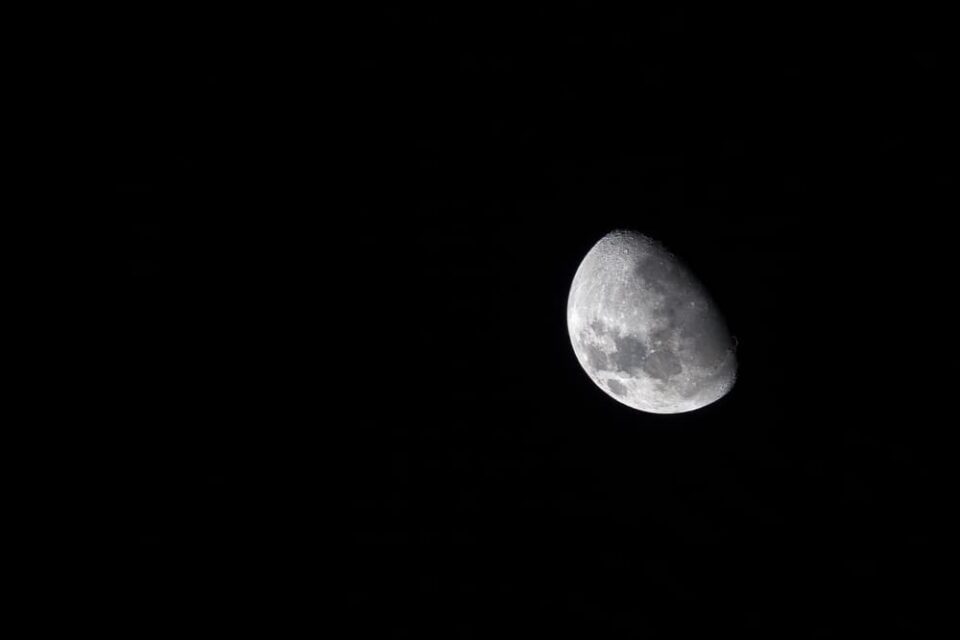
Fly Me to the Moon! How Many Moon Phases Are There?
Gazing up at the Moon is a timeless, awe-inspiring pastime that has linked generations and cultures in universal wonder, perhaps since the dawn of humanity. If your young explorer has yet to point up at that glowing sphere in the night sky and ask you about it, they will. It’s as inevitable as the tide. Here’s some fuel to help them blast off on their quest to get better acquainted with our nearest celestial neighbor.
What Is the Moon?
The Moon is a dust-covered space rock with an otherworldly landscape of mountains and craters that’s roughly one-quarter the size of Earth. In astronomy, it’s known as a natural satellite because it travels around our planet in a squashed circle path called an elliptical orbit. A single orbit takes approximately 27 days to complete. Even though it’s our closest neighbor in the sky, it’s approximately 238,855 miles away. That means if you were able to drive there in a car traveling at freeway speed, the journey would take roughly 3,500 days—nearly 10 years (plus stops for bathroom breaks).
Scientists aren’t exactly sure, but studies suggest a Mars-sized planet crashed into Earth approximately 4.5 billion years ago. This collision threw massive amounts of geological debris into space, and eventually, that mess clumped together to form the Moon.
Even though it’s far away, the Moon plays an important role for every living thing on Earth. It generates tides in the oceans, regulates our climate, and helps stabilize our planet as it turns on its axis. And what about that captivating glow? When you and yours gaze up at that breathtaking lunar gleam, you aren’t looking at light produced by the Moon. You’re seeing sunlight reflected off the Moon’s surface down to us here on Earth. That reflected light travels so fast that it only takes a little more than a second to reach us.
And what about the nights when there appears to be no Moon in the sky? Or only half? What’s happening then? Your curious young stargazer is sure to have noticed these changes, and we’ve got answers to their questions. Buckle up for blastoff! It’s time for them to discover the phases of the Moon.
What Are Moon Phases?
Have you ever noticed how the Moon seems to change shape from day to day? One night, you see a full silvery-white circle. On others, you only see half or a tiny curved sliver of moonlight. Sometimes, you can’t see the Moon at all. What’s going on?
It may seem like an ongoing disappearing-reappearing magic trick, but what you’re actually observing are the fascinating phases of the Moon.
What Causes the Phases of the Moon?
So, why does the Moon take center stage in the sky on some evenings, while on others it appears to have taken the night off? In short, where the Moon is in relation to the Sun and Earth causes this to happen. One half of the Moon is constantly illuminated by light reflected off the Sun, and the other half is completely dark. As the Moon orbits Earth, it appears to grow and shrink depending on how much of the lit half we can see. This cycle lasts approximately 29 days and causes the phenomenon known as the lunar phases or Moon phases.
Wondering how many Moon phases there are? Well, wonder no more. As the Moon orbits Earth, it goes through a total of eight phases. Each has a name that describes whether the lit-up surface we can see is growing (“waxing”) or shrinking (“waning”). Completing all eight phases means the Moon has gone through one full lunar cycle.

Here are the Moon phases in order:
- New Moon: When the Moon sits between Earth and the Sun, it reflects the light away from our planet, so it appears completely dark from our perspective.
- Waxing crescent: During this phase, the first curved edge of the Moon slowly grows larger from one night to the next.
- First quarter: The Moon’s surface appears to be divided into two halves, one shining brightly and the other shadowed. Also called the half Moon, the first quarter occurs when the Moon has completed one-quarter of its trip around Earth.
- Waxing gibbous: At this stage, more than one-half of the Moon is illuminated and continues to grow nightly.
- Full Moon: The Moon is directly opposite the Sun and has reached the halfway point of its trip around Earth, allowing us to see its entire surface reflecting sunlight.
- Waning gibbous: The Moon’s surface area facing the Sun is shrinking as it begins to complete its orbit.
- Third quarter: At this point, the Moon has completed three-quarters of its orbit. Looking up at the night sky, you’ll see a mirror image of the first quarter Moon.
- Waning crescent: During this phase, the Moon shrinks into what appears to be a slim, curved sliver as it travels the last quarter of its trip around Earth.
Your location on the globe determines which part of the Moon the Sun illuminates. For those living in the Southern Hemisphere, the Moon’s left side will light up during the first quarter phase. Those living in the Northern Hemisphere will see the right side instead. On nights of the third quarter Moon, you’ll see the opposite side of the Moon lit up. It’s all a matter of perspective.
Your space explorer’s next question will probably be, “How long does each Moon phase last?” Each intermediate phase (for example, the new Moon to the first quarter Moon) takes approximately seven days. The full Moon and the new Moon appear in the sky for three nights each.
Are Moon Phases the Same as an Eclipse?
No. According to NASA, an eclipse occurs when one celestial body moves into the shadow of another. Two kinds of eclipses are visible from Earth.
- Lunar eclipse: A lunar eclipse occurs when Earth’s orbit positions it directly between the Sun and the Moon. Earth’s shadow lands on the Moon’s surface, keeping it from reflecting any sunlight. Lunar eclipses only happen during a full Moon.
- Solar eclipse: When the Moon moves between the Sun and Earth, it causes a solar eclipse. Depending on the alignment, the Moon blocks some (partial eclipse) or all (total eclipse) of the Sun’s light from reaching us here on Earth. (It’s important to protect everyone’s eyes by never looking directly at the Sun during a solar eclipse. Always be sure to use protective glasses approved for watching eclipses or a solar eclipse viewer.)
Are There Different Names for the Moon?
Humanity has a long cultural relationship with the Moon. Since the first humans watched their first moonrise, this natural satellite has influenced every aspect of human lives, from medicine and science to art and religion. Over time, the Moon has received many different names from the world’s peoples. Many Native American cultures have a unique name for each of the 12 or 13 Moons that appear in the sky throughout the year.
- JANUARY – WOLF MOON: Named after the hungry wolves howling for food during the harsh winter.
- FEBRUARY – SNOW MOON: February is typically the harshest, snowiest month in most of North America.
- MARCH – WORM MOON: The world is warming up, and the first evidence of the spring is the worm trails found in the freshly thawed soil.
- APRIL – PINK MOON: April’s Moon takes its name from the color of the first flowers that bloom in spring.
- MAY – FLOWER MOON: Flowering plants come into full bloom during May, so it’s fitting to give the Moon this name that month.
- JUNE – STRAWBERRY MOON: Berries come into season starting in June, with strawberries being the first of the sweet bounty to be harvested.
- JULY – BUCK MOON: July is when male deer begin regrowing their antlers after shedding them in the fall.
- AUGUST – STURGEON MOON: Native American nations with a strong fishing tradition named August’s Moon after sturgeon, which begin their migration during this month.
- SEPTEMBER – FULL CORN MOON: The Moon is exceptionally bright in September. It’s also the beginning of the harvest, and the additional light allows gatherers to work late into the night, bringing in their crops.
- OCTOBER – HUNTER’S MOON: This is another bright month for the Moon, named for the additional light it provides that helps hunters gather game before the long winter.
- NOVEMBER – BEAVER MOON: This name honors the time of year when beaver traps were set just before winter.
- DECEMBER – COLD MOON: Days are short, nights are long, and the weather’s chilly. Could there be a better name for the Moon as it graces the December sky?

Even More Names!
The Moon carries many other names you’re bound to hear in the news or conversation. Here are a few.
- BLUE MOON: You’ve probably heard the expression “once in a blue Moon.” In conversation, the term refers to a rare event, but in the literal sense, a blue Moon is an actual astronomical event. Because the lunar month is shorter than the standard calendar month, full Moons don’t always occur on the same dates. After two or three years, the lunar cycle syncs to produce two full Moons in a single month.
- HARVEST MOON: This is one of the most famous names for the Moon, having taken a storied place in poems and songs for centuries. The harvest Moon is the full Moon that occurs nearest the autumnal equinox, when the length of the day exactly matches that of the night. The Moon’s light allows the farmers to work longer in the fields, helping them bring in the harvest before the first frosts of fall.
- SUPERMOON: Another dazzling event, a supermoon occurs when a full Moon takes place while the Moon is at the closest point in its orbit to Earth. Its proximity makes it appear bigger in the night sky than at any other time.
Blast Off to the Moon!
Your budding astronaut probably can’t wait to discover all there is to know about the Moon. Why not encourage them to create their own Moon phase calendar? Take them outside every night to see each new Moon phase, and have them draw a picture in a date book or calendar to record how the Moon changes from night to night.
If you want a low-key activity, pull out a blanket, make some hot chocolate, and enjoy the next full Moon with a bit of stargazing. Whatever you choose to do, you’ll have a wonderful time under the stars with your child, who’s bound to feel special staying up late.
Explore the Wonders of the Solar System
Once you and your kids have unearthed all the Moon’s secrets, why not set their sights on other planets? Compare the many moons of Jupiter with our own, or check out the rings of Saturn. Or you could launch into exploring the world’s mythologies, starting with using the Chinese lunar calendar to discover your kid’s zodiac animal.
Then ignite your child’s desire to experiment and explore science and technology with our Science Junior subscription box. It’s the perfect way to launch them into a universe full of fun and discovery.
